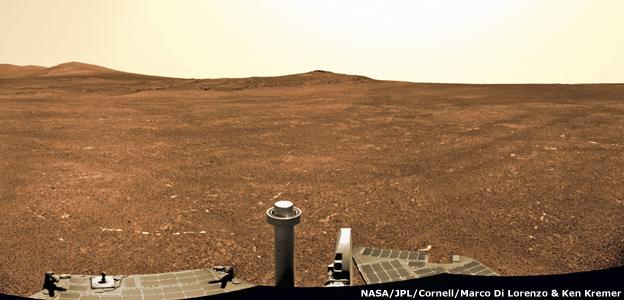Old Opportunity Mars rover makes rock discovery
- Published
- comments

In this panorama, Solander Point is the near peak on the left of the horizon. It is more than a kilometre away from Opportunity's current position and the rover would hope to arrive by August (www.kenkremer.com)
Nasa's ageing Opportunity rover on Mars has just made what may be one of its most significant discoveries to date.
The nine-year-old robot has identified rock laden with what scientists believe to be clay minerals.
Their presence is an indication that the rock, dubbed Esperance, has been altered at some point in the past through prolonged contact with water.
Opportunity has seen a clay-bearing outcrop before but scientists say this is by far the best example to date.
"It's very rich," said Steve Squyres, the rover's principal investigator.
"We've been discovering evidence for water on Mars since we first landed back in 2004. What's different here?
Steve Squyres: Opportunity's shoulder joint is now "kinda gimpy"
"If you look at all of the water-related discoveries that have been made by Opportunity, the vast majority of them point to water that was a very low pH - it was acid.
"We run around talking about water on Mars. In fact, what Opportunity has mostly discovered, or found evidence for, was sulphuric acid.
"Clay minerals only tend to form at a more neutral pH. This is water you could drink. This is water that was much more favourable for things like pre-biotic chemistry - the kind of chemistry that could lead to the origin of life."
Prof Squyres, who is affiliated to Cornell University, Ithaca, New York, said he was inclined to put Esperance in his personal top five discoveries made on the Red Planet by Opportunity and her twin rover, Spirit, which stopped working in 2011.

Esperance is the most clay-laden rock seen by Opportunity in its nine and a half years on Mars
The clays are aluminium-rich, possibly of the type montmorillonite. However, because Opportunity's X-ray spectrometer can only discern the atomic elements in a rock, and not their mineralogical arrangement, no-one can say for sure.
Nonetheless, the mere occurrence of clays is further proof that Mars was much warmer and wetter billions of years ago; a very different place to the cold, desiccated world it has become.
And these results complement nicely those of Nasa's newer rover Curiosity, which has also identified clays at its landing site almost half-way around the planet's equator.
The old robot made its find at a location called Cape York, which is sited on the rim of a 22km-wide crater known as Endeavour.
Mission managers have now commanded it to start moving along the ridge to a destination dubbed Solander Point.
There is an expectation that Opportunity will find a deeper stack of rocks at the new location to follow up the Esperance water story.
"Maybe [we can] try to reconstruct the actual depositional environment of these materials and whether they were lacustrine - that is, formed by a lake - or fluvial (river) or an alluvial fan (network of streams), or whatever," said deputy principal investigator Ray Arvidson, of Washington University, St Louis.
'Daily gift'
Opportunity is now operating well beyond its expected lifetime.
When it landed at Eagle Crater in January 2004, Nasa hoped to get at least 90 working Martian days (sols) from the machine. Remarkably, it continues to roll beyond 3,300 sols.
It has an "arthritic" robotic arm, its solar panels are losing efficiency, and it drives backwards to save wear on its locomotion system.
It is also now having to contend with glitchy flash memory. But the US space agency is determined to keep pushing the vehicle for as long as possible.
"Remember, the rover continues in a very hostile environment on Mars," said John Callas, Nasa's Opportunity project manager.
"The rover could have a catastrophic failure at any moment. So, each day is a gift."
Jonathan.Amos-INTERNET@bbc.co.uk and follow me on Twitter: @BBCAmos, external
- Published6 June 2013
- Published31 May 2013
- Published7 December 2012